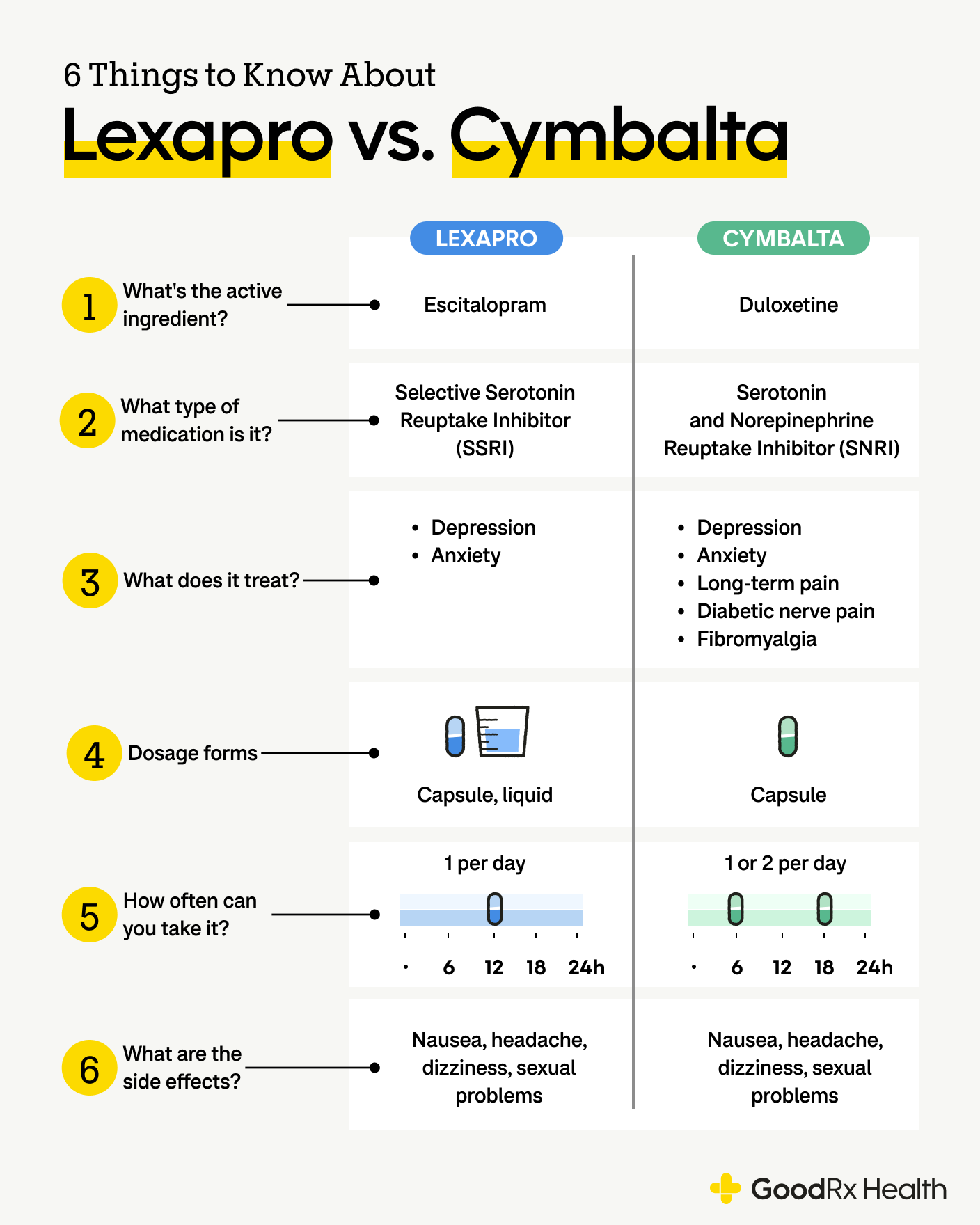Key takeaways:
Lexapro (escitalopram) and Cymbalta (duloxetine) are two popular antidepressants. Lexapro is a selective serotonin reuptake inhibitor (SSRI). Cymbalta is a serotonin and norepinephrine reuptake inhibitor (SNRI).
Lexapro and Cymbalta work differently and have varying FDA-approved uses. Both are oral medications. But you’ll probably take Lexapro once a day, while you might take Cymbalta once or twice a day.
Lexapro and Cymbalta share many side effects, such as nausea, sweating, and sexual problems. They also share substance and drug interactions, such as alcohol, blood thinners, and some opioid pain relievers.
Cymbalta and most forms of Lexapro are available as brand-name medications. But you can also find them as lower-cost generics. GoodRx may be able to help make your prescription more affordable.
Save on related medications
There are many options when it comes to managing depression. For many people, antidepressants are an essential part of their treatment plan. If you’ve never taken an antidepressant before, the number of available medications may seem overwhelming.
Two options you may see come up frequently are Lexapro (escitalopram) and Cymbalta (duloxetine). Experts consider them both first-choice options for managing depression. But if they work well for depression, how do you work with a healthcare professional to choose one?
There’s no single answer to that question. Many factors, such as dosage forms, side effects, and interactions, might help you choose one with your prescriber. Below, we discuss six things to keep in mind if you’re comparing Lexapro versus Cymbalta.
Search and compare options

1. Lexapro and Cymbalta work in slightly different ways
Lexapro and Cymbalta work slightly differently in your body. Despite this difference, they both provide similar effects for managing depression.
Lexapro is a selective serotonin reuptake inhibitor (SSRI). It helps boost levels of serotonin in your brain. Serotonin is a chemical messenger that helps regulate mood and sleep, among other functions of the body.
Cymbalta is a serotonin and norepinephrine reuptake inhibitor (SNRI). Like Lexapro, it helps boost serotonin levels. But Cymbalta also increases levels of norepinephrine in your brain. Norepinephrine is a chemical messenger that helps improve focus, attention, and energy.
2. Lexapro and Cymbalta have different FDA-approved uses
Lexapro and Cymbalta also have different FDA-approved uses.
Lexapro is approved to treat major depressive disorder (depression) in adults and children age 12 and older. It’s also approved to treat generalized anxiety disorder in adults.
Cymbalta is approved for more conditions than Lexapro. Cymbalta is FDA approved to treat:
Major depressive disorder in adults
Generalized anxiety disorder in adults and children age 7 and older
Diabetic peripheral neuropathy (nerve pain due to diabetes) in adults
Fibromyalgia in adults and children age 13 and older
Chronic pain in the muscles, bones, or joints in adults
Antidepressants for anxiety: Lexapro (escitalopram) and Cymbalta (duloxetine) are both FDA approved to treat anxiety. Find out how they work and what to expect.
SSRIs vs. SNRIs: Learn more about how two types of antidepressants — selective serotonin reuptake inhibitors (SSRIs) and serotonin and norepinephrine reuptake inhibitors (SNRIs) — compare.
How to know your medication is working: Experts discuss the common signs that your antidepressant is working — and what to do if it’s not.
This difference in approved uses and age ranges can be a reason a prescriber may choose one medication over the other.
3. Lexapro and Cymbalta start to work in about the same amount of time
Even though Lexapro and Cymbalta work differently, they take about the same amount of time to work. Both antidepressants may start working about 1 to 2 weeks after you start taking one of them. But it usually takes about 4 to 8 weeks (1 to 2 months) for most people to experience Lexapro’s or Cymbalta’s full effects.
If you’ve been taking Lexapro or Cymbalta for a month and your symptoms don't improve at all, let your prescriber know. They may suggest a dosage change or trying a different antidepressant.
Save on medications with GoodRx
4. Lexapro and Cymbalta come in different dosage forms
Lexapro and Cymbalta are both oral medications. But they come in different dosage forms and have different directions for taking them.
Lexapro comes as an oral tablet and oral solution. Regardless of which form you take, you’ll likely only take it once a day.
Cymbalta comes as an oral capsule that you should swallow whole. There’s also a version of duloxetine (Cymbalta’s active ingredient) called Drizalma Sprinkle capsules. You can open and sprinkle the contents of these capsules over applesauce. Depending on your response to Cymbalta or Drizalma Sprinkle, you may take it once or twice a day.
5. Lexapro and Cymbalta have similar side effects
Lexapro and Cymbalta have similar side effects. Most people can take either without major problems. But you may find that one is easier to tolerate than the other. Your prescriber should work with you to find an antidepressant that works well with the least amount of side effects.
The table below provides a side-by-side comparison of common and rare side effects for Lexapro and Cymbalta. Keep in mind this isn’t a complete list of all possible side effects for either. You should always let your prescriber know if you’re experiencing unusual symptoms, even if they’re not listed here.
| Lexapro side effects | Cymbalta side effects |
|---|---|
Common side effects:
|
Common side effects:
|
Rare but serious side effects:
|
Rare but serious side effects:
|
6. Lexapro and Cymbalta have similar interactions
Lexapro and Cymbalta also share similar interactions. Most interactions raise the risk of either serotonin syndrome or serious bleeding. Make sure you share a full medication list with your prescriber and pharmacist before starting Lexapro or Cymbalta. This can help them catch and manage potentially dangerous interactions.
Lexapro and Cymbalta both interact with:
Alcohol
Monoamine oxidase inhibitors (MAOIs), such as selegiline (Zelapar, Emsam)
Other SSRIs, such as fluoxetine (Prozac)
Other SNRIs, such as venlafaxine (Effexor XR)
Tricyclic antidepressants, such as amitriptyline
Certain opioid pain relievers, such as tramadol (ConZip)
Triptan migraine medications, such as sumatriptan (Imitrex, Tosmyra)
St. John’s wort (an over-the-counter supplement)
Blood thinners, such as warfarin (Coumadin, Jantoven) and clopidogrel (Plavix)
Nonsteroidal anti-inflammatory drugs (NSAIDs), such as aspirin and ibuprofen (Advil, Motrin)
There is one unique difference when it comes to interactions with Lexapro and Cymbalta. Very rarely, Lexapro can cause an abnormal heart rhythm called QT prolongation. The risk of this side effect goes up if you combine Lexapro with other medications that cause it.
So if you take another medication that can cause QT prolongation, you may want to avoid Lexapro. Cymbalta isn’t linked to this side effect and could be an alternative to help avoid this interaction.
Can you take Lexapro and Cymbalta together?
No. You shouldn’t take Lexapro and Cymbalta at the same time. Keep in mind that they interact with each other. Taking them together raises the risk of serotonin syndrome, which can be fatal in severe cases.
If you feel Lexapro or Cymbalta isn’t working well enough on its own, tell your prescriber. There are other antidepressants, such as bupropion (Wellbutrin XL), which are safer to combine with SSRIs or SNRIs. Your prescriber may consider adding one of these to your regimen. Or they may suggest switching antidepressants. You may find that one antidepressant works better for you than others.
How to save on Lexapro and Cymbalta
There are ways to save on Lexapro and Cymbalta. Cymbalta and most forms of Lexapro are available as brand-name medications. But you can also find them as lower-cost generics. GoodRx may be able to help you save over 75% off the average retail price of the generic versions of Lexapro and Cymbalta.
With a free GoodRx coupon, the price for 30 tablets of 10 mg generic Lexapro may be as low as $9.60. And 30 capsules of 60 mg generic Cymbalta may cost as low as $10.20.
The bottom line
Lexapro (escitalopram) and Cymbalta (duloxetine) are two first-choice antidepressants. They have several differences to know about when comparing them. Lexapro is a selective serotonin reuptake inhibitor (SSRI). Cymbalta is a serotonin and norepinephrine reuptake inhibitor (SNRI).
Lexapro and Cymbalta are both FDA approved to treat depression and anxiety. But they’re approved for different age groups. Cymbalta is also approved to treat certain chronic pain conditions, such as fibromyalgia and diabetes nerve pain.
Lexapro and Cymbalta share similar side effects and interactions. But there are a few differences between them. These distinctions can help you and your prescriber decide if one of them might be right for you.

Why trust our experts?


References
Endocrine Society. (2022). Adrenal hormones.
Lupin Pharmaceuticals, Inc. (2023). Duloxetine- duloxetine capsule, delayed release [package insert].
McQuaid, J. R., et al. (2019). APA clinical practice guideline for the treatment of depression across three age cohorts. American Psychological Association.
RedPharm Drug, Inc. (2020). Escitalopram- escitalopram tablet, film coated [package insert].
Sun Pharmaceutical Industries, Inc. (2023). Drizalma Sprinkle- duloxetine capsule, delayed release [package insert].














